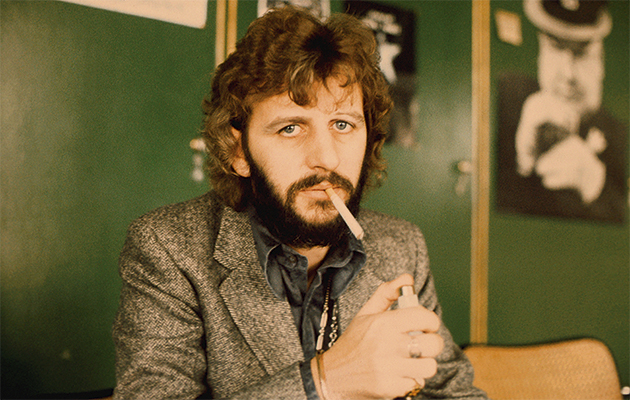Knighted in the New Year Honours, Ringo Starr is still, at 77, doing his best to provide what Buckingham Palace calls “services to music”. Last September he released his 19th solo album (Give More Love) and followed it with an American tour. Audiences in 11 European countries will get a chance t...
Knighted in the New Year Honours, Ringo Starr is still, at 77, doing his best to provide what Buckingham Palace calls “services to music”. Last September he released his 19th solo album (Give More Love) and followed it with an American tour. Audiences in 11 European countries will get a chance to see him perform with his All-Starr Band this summer. Judging from the itinerary, he’ll celebrate his 78th birthday (July 7) somewhere between Tuscany and Monte Carlo.
Peace, love and many happy returns. But while most music fans will never hear a note of Give More Love, and might be hard-pressed to name the 18 albums that preceded it, Starr’s services to music as a solo artist should not be forgotten. There was a time, not long after The Beatles split, when he was the most successful of them all, topping the US singles chart twice in 1973-4 (“Photograph”, “You’re Sixteen”) and almost having a US No 1 album (Ringo). He took a major acting role in a popular film (That’ll Be The Day), co-produced another (Son Of Dracula) and signed up to play the Pope in a third (Lisztomania). He even managed – if one made allowances for physical and geographical separation – to get the old Beatle gang back together.
Reissued on 180-gram vinyl (no extras, unfortunately, although Ringo comes with the original Klaus Voorman-designed booklet), the aforementioned Ringo (1973) and its follow-up Goodnight Vienna (1974) definitely catch Starr at a peak. The first LP uses 23 guest musicians, the second 26, and this tends to be a super-echelon of rock VIP that only someone as socially skilled as Ringo could enlist. Contributors across the two albums include four-fifths of The Band; George Harrison, Steve Cropper and Marc Bolan on guitars; and a stunning roll-call of keyboard players including Nicky Hopkins, Elton John (whose Goodbye Yellow Brick Road kept Ringo at No 2), Billy Preston, Paul McCartney and John Lennon. In rallying to the Ringo cause and offering him original material, the other Beatles may, in fact, have overcompensated to their own detriment. Ringo, driven by the worldwide success of “Photograph”, threatened to completely overshadow Lennon’s ’73 album Mind Games.
But Ringo isn’t just some goodwill project that got out of hand. It’s the best album he ever made for a start, and much of that is down to the man himself. If “Photograph”, the beautiful song he wrote with Harrison, is the clear standout, we can also see why his cover of The Sherman Brothers’ “You’re Sixteen” – and, for that matter, his self-penned “Oh My My” – had runaway popular appeal. Not one of them sermonises, satirises, points a finger or carries a banner, unlike certain 1972–3 singles by Harrison, Lennon and McCartney. Unpretentious and easy to warm to, they were the perfect advertisements for a Starr album that had a bit of C&W, a bit of rock’n’roll, a bit of granny music, a bit of grease in its hair, a bit of an Abbey Road vibe and a bit of laughter at Starr’s own expense.
The rancour of the Fabs’ divorce (captured sardonically by Harrison in his ’73 song “Sue Me, Sue You Blues”) was obviously real enough, but Ringo’s convivial personality ensured that no bitterness seeped into the grooves. “I’m The Greatest”, a Lennon composition, enabled him to strike just the right tone for the occasion. A song about a man marked for greatness from the day he is born, it would have dripped with sarcasm if Lennon had sung it. Delivered in Ringo’s underdog croon, the lyrics are sweet, incongruous and funny, like a Sunday league footballer scoring a tap-in and running off to celebrate like a galáctico. Then again, an ex-Beatle hardly moves in amateur circles. The LA recording sessions for “I’m The Greatest”, which had a core personnel of Starr, Lennon, Harrison and Klaus Voormann, caught the attention of the media, leading to intense speculation that a Beatles reunion was imminent. But although McCartney did his bit on Ringo, proffering the song “Six O’Clock” and ‘singing’ a mock-kazoo solo in “You’re Sixteen”, he recorded his parts in London, not LA. The four of them never flew so close to each other’s orbits again.
Goodnight Vienna, arriving a year later in November ’74, began with another Lennon song (“It’s All Down To Goodnight Vienna”) and retained many of the same faces, including Voormann, Cropper, Robbie Robertson and producer Richard Perry, with a view to repeating Ringo’s platinum sales. But the same magic wasn’t quite there. McCartney and Harrison were unable to participate owing to schedule conflicts, and Harrison in particular was missed; nothing on Goodnight Vienna rivalled “Photograph” for poignancy and elegance. The big hit singles on the album were Hoyt Axton’s calypso-tinged “No No Song” (US No 3) and Starr’s affectionate take on The Platters’ “Only You” (US No 6), but it was Elton John and Bernie Taupin who supplied the catchiest track, “Snookeroo”, a paean to hard work and hard drinking in the industrial north that, while not exactly “Saturday Night’s Alright For Fighting”, rocked reassuringly harder than the lightweight ditties surrounding it.
The decline was swift. In 1976–7, with McCartney’s Wings commercially rampant, Ringo’s goodwill ran out. He made a disastrous disco record (Ringo The 4th). The lure of the Hollywood Vampires proved irresistible. It would be many, many years before his services to music were required again.



